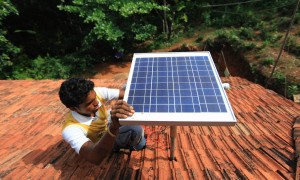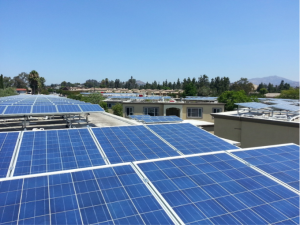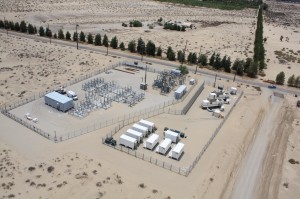As the price of solar panels and batteries decreases, our electricity system is starting to look a lot cleaner and more decentralized. While some people think the rise of community-based electricity technologies will undermine utilities, utilities are in fact embracing one version of decentralized power: microgrids.
Utilities are finding microgrids to be a great resilience strategy for avoiding outages, particularly in rural areas or crucial population or job centers. Greentech Media reports on the trend:
San Diego Gas & Electric delivers power to the town of Borrego Springs via a single radial transmission line running through the desert. Lightning strikes and desert flash floods threaten that line, resulting in historically poor reliability, Chief Engineer Thomas Bialek explained at the DistribuTech panel.
The utility needed to maintain or improve reliability for the nearly 2,800 Borrego Springs customers, but the traditional fix — building out a parallel transmission line — was pricey. A microgrid would be three or four times cheaper, Bialek said. So that’s what they did.The system, paid for by SDG&E, the Department of Energy and other partners, combines diesel generators, large and small batteries, and rooftop solar PV.
The microgrid has already proven itself in the face of adversity. When a flash flood in September 2013 downed transmission poles and lines leading to the town, the microgrid fired up and restored power to 1,056 customers while the grid repairs unfolded. That covered the core city center, so that those residents who didn’t have power yet could move to central facilities for shelter from the heat.
The future portends even more investment in microgrids, as Utility Dive notes:
Last year, GTM Research estimated there were 156 operational microgrids in the country, making up 1.54 GW of capacity, and that number is expected to rise to 3.71 GW by 2020. Globally, Transparency Market Research believes the microgrid market will be worth about $35 billion by 2020 — up from $10 billion in 2013.
But as microgrids — and the technologies that underpin them — become cheaper, utilities may be sowing the seeds of their own destruction. With a few additional breakthroughs, these technologies could eventually allow entire communities to defect from the grid, leaving utilities and their remaining ratepayers stuck with stranded assets.
But for now, these installations will provide an environmental and energy win, while furthering investment in the technologies needed to clean and decentralize the electricity sector.
 Just like the developing world has leapfrogged wealthy countries with telecommunications — jumping right to cell phones over land lines — it may be doing the same with clean electricity grids.
Just like the developing world has leapfrogged wealthy countries with telecommunications — jumping right to cell phones over land lines — it may be doing the same with clean electricity grids.
Greenbiz reports on some of the microgrids being deployed in developing countries like Haiti, involving solar, some energy storage, and “internet of things” monitoring and control for customers. Essentially, the software can deploy specific amounts of electricity to individual customers based on their needs, like lighting and television watching. If they don’t pay, they lose service, but can restore it the next day if they have the money:
“We started with the idea that the poorest people in the world make the shrewdest financial decisions,” said [business owner] Thakkar. And he believes they have proved their point.
“Our first customer was an old gentleman in a small village. Everyone in the village came out to listen to our presentation. He asked two or three questions and then went back in his hut and came out with 1,000 rupees, which was the equivalent of about $20. He said, ‘Great, give it to me,'” he recalled of the 2008 start of the company.
The big difference in these low-income markets is that many customers just want basic electricity service for things like lights and charging phones. Obviously, developed markets have much more intense electricity needs.
But by scaling the market at this initial step, we’re learning what works and what doesn’t. And as costs come down and the business model proves itself, it could become a model that scales to the developed world. While the vision of communities going completely off grid may still be impractical or too expensive, these developing world examples show that we can get pretty far along that path. And with new technological breakthroughs, it could one day even enable a complete break with the traditional grid model even in the developed world.
 Utilities may hate rooftop solar for cutting into their profits, but they seem to like community solar. In these arrangements, consumers buy into a local solar PV project that could be small enough to fit on a Little League field. The local utility buys the electricity and then reduces the customers’ electric bills based on how much the utility purchases.
Utilities may hate rooftop solar for cutting into their profits, but they seem to like community solar. In these arrangements, consumers buy into a local solar PV project that could be small enough to fit on a Little League field. The local utility buys the electricity and then reduces the customers’ electric bills based on how much the utility purchases.
This is a great option for renters and apartment dwellers who don’t have their own roof space and therefore no access to their own solar arrays.
Bloomberg reports on the new wave of community solar taking off like rooftop did:
“Utilities see community solar as a bit more friendly,” said Drew Warshaw, vice president of community solar at NRG Energy. “By definition we have to use their transmission and distribution system, we pay for any upgrades needed and they continue to have a relationship with the customer.”
Still, utilities are closely watching how this initiative plays out, mainly related to lost revenue, according to Chief Executive Officer Jim Torgerson of Avangrid Inc., which owns utilities in New York and New England.
“Shared solar has much better economies of scale than rooftop but net metering issues really have to get resolved,” he said in a phone interview. “We think it’s worth the wholesale price of power, not the retail rate.”
Even with this utility hesitancy, the future for community solar seems brighter than for rooftop, given the more pro-utility bent of the contracts. So right now utilities may be okay with the arrangement.
But it may just be a matter of time before the technology improves enough to displace traditional large-scale utilities. As solar and battery prices come down, many communities will be able to essentially become their own utilities, with links to neighboring microgrids.
If that comes to pass, community solar may hasten the end of the traditional utility.



